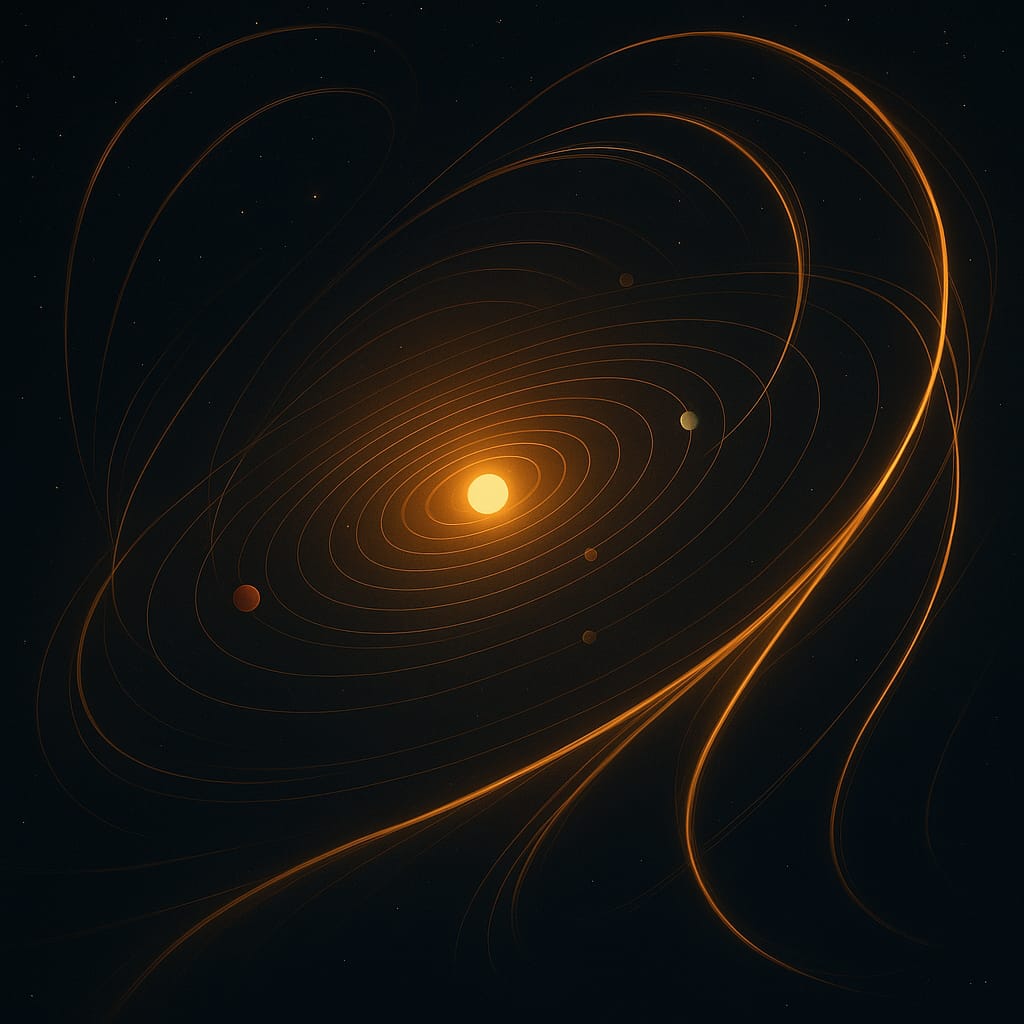The three concepts of “Black Holes,” “Light,” and “Energy,” along with their characteristics, properties, and utility
What exactly is a black hole
A black hole is a region in space where the gravitational pull is so strong that nothing, not even light, can escape its gravitational field. This phenomenon occurs when massive stars exhaust their nuclear fuel and undergo gravitational collapse. It is one of the most intriguing and extreme objects in the universe.
The gravitational force of a black hole is a consequence of its mass being concentrated in an incredibly small volume. The boundary of a black hole is called the event horizon. Once an object crosses the event horizon, it is said to be inside the black hole, and it is impossible for anything inside to communicate or escape to the outside universe.
Black holes come in different sizes, categorized by their mass
Stellar black holes
Formed from the remnants of massive stars that have undergone a supernova explosion. These have masses several times that of our Sun but are typically still relatively small in astronomical terms.
Intermediate black holes
They have masses between stellar black holes and supermassive black holes, ranging from thousands to millions of solar masses. Their formation mechanism is not yet fully understood.
Supermassive black holes
Found at the centers of most galaxies, including our Milky Way. These are enormous, with masses ranging from millions to billions of times that of the Sun. Their origins are also not entirely clear, but they likely form through the accretion of matter and the merging of smaller black holes.
Black holes are fascinating objects of study in astrophysics and cosmology. They have profound effects on nearby matter and influence the dynamics of galaxies. When matter falls into a black hole, it forms an accretion disk, generating intense radiation and powerful jets of particles that can be observed from great distances.
However, because they do not emit light or other forms of electromagnetic radiation, black holes themselves cannot be seen directly. Instead, astronomers detect their presence and study their properties through the effects they have on nearby objects and the surrounding space.
What exactly is light
Light is a type of electromagnetic radiation, which is a form of energy that travels in waves. It is a fundamental component of the electromagnetic spectrum, which includes a wide range of wavelengths from radio waves to gamma rays.
In the context of visible light, it is the portion of the electromagnetic spectrum that can be detected by the human eye, and it enables us to see the world around us. Visible light wavelengths range from approximately 400 to 700 nanometers, with violet having the shortest wavelengths and red having the longest.
Here are some key characteristics of light
Speed
Light travels through a vacuum at a constant speed of approximately 299,792 kilometers per second (about 186,282 miles per second), denoted by the symbol “c.” This is the fastest speed at which anything can travel in the universe.
Dual Nature
Light exhibits both wave-like and particle-like properties. This duality is described by the theory of quantum mechanics, where light can behave as discrete packets of energy called “photons” while also exhibiting wave-like interference patterns.
Transmission
Light can travel through transparent or translucent materials like air, water, glass, and certain plastics. It can also pass through a vacuum, as mentioned earlier.
Interaction
When light encounters an object or a surface, it can be reflected, absorbed, or transmitted. The color of an object is determined by the wavelengths of light it reflects and absorbs.
Spectrum
As mentioned earlier, light consists of a continuous range of wavelengths, each corresponding to a different color in the visible spectrum.
Electromagnetic Waves
Light is part of the broader family of electromagnetic waves, which includes radio waves, microwaves, infrared radiation, ultraviolet radiation, X-rays, and gamma rays. Each type of electromagnetic wave has different wavelengths and properties.
Light plays a crucial role in astronomy, physics, and everyday life. It allows us to observe distant celestial objects, provides energy for photosynthesis in plants, and enables us to see and perceive the world around us. The study of light and its interactions with matter has led to numerous technological advancements and a deeper understanding of the nature of the universe.
What exactly is energy
Energy is a fundamental concept in physics that refers to the ability of a system to do work or to cause a change. It is a scalar quantity, which means it has magnitude but no direction. Energy comes in various forms, and it can be transformed from one form to another.
The concept of energy is essential because it is conserved in a closed system, meaning that the total energy of a closed system remains constant over time, even as it changes between different forms. This principle is known as the conservation of energy.
There are several different forms of energy
Kinetic Energy
This is the energy associated with the motion of an object. The kinetic energy of an object depends on its mass and its velocity. For example, a moving car or a running athlete possesses kinetic energy.
Potential Energy
This is the energy that an object possesses due to its position or configuration relative to other objects. There are different types of potential energy, such as gravitational potential energy, elastic potential energy, and electric potential energy. For instance, a ball held above the ground has gravitational potential energy because of its height above the Earth’s surface.
Thermal (Heat) Energy
This is the energy associated with the internal motion of atoms and molecules within a substance. It is related to the temperature of the object. Heat energy is crucial for many processes, including those in living organisms and machines.
Chemical Energy
This is the energy stored in chemical bonds between atoms and molecules. When chemical reactions occur, energy may be released or absorbed.
Nuclear Energy
This is the energy stored within atomic nuclei. It is released during nuclear reactions, such as nuclear fission and nuclear fusion.
Electromagnetic Energy
This includes various forms of energy carried by electromagnetic waves, such as light, radio waves, microwaves, X-rays, and gamma rays.
Energy can be converted from one form to another, and the total energy remains constant in a closed system. For example, when you drop a ball from a height (converting gravitational potential energy into kinetic energy), it gains speed and kinetic energy as it falls. Upon hitting the ground, some of this kinetic energy is converted into sound energy and thermal energy due to the impact and friction.
Understanding and harnessing energy is crucial for many aspects of our daily lives, from powering our homes and vehicles to advancing technology, industry, and scientific research. It is a central concept in physics and plays a critical role in the functioning of the universe.

Table summarizing the three concepts of “Black Holes,” “Light,” and “Energy,” along with their characteristics, properties, and utility
| Concept | Characteristics and Properties | Utility |
| Black Holes | – Regions of intense gravitational pull. – Formed from massive stars’ collapse. – Have an event horizon from which nothing escapes. | – Study extreme conditions in the universe. – Influence dynamics of galaxies. – Provide insights into space-time curvature. |
| Light | – Electromagnetic radiation in the visible spectrum. – Travels at a constant speed in a vacuum (speed of light). – Exhibits both wave and particle-like properties (photon). | – Enables vision and sight perception. – Used in communication (fiber optics). – Supports photosynthesis in plants. |
| Energy | – The ability to do work or cause change. – Comes in different forms (kinetic, potential, thermal, etc.). – Conserved in a closed system (law of conservation of energy). | – Powers various systems and devices. – Drives vehicles and machinery. – Fuels human activities and industries. |
The utility of these concepts goes beyond the listed points, and they have significant implications and applications in multiple fields of science, technology, and our daily lives.
If a black hole has no shadow, can it be that it is a kind of reversed light?
The concept of a black hole having “no shadow” is related to its gravitational properties rather than being a kind of “reversed light.” The “shadow” of a black hole refers to the dark region surrounding it, which results from the bending of light due to the immense gravitational pull of the black hole.
When light or any electromagnetic radiation approaches a black hole, it can get deflected and bent by the strong gravitational field. As a result, the black hole creates a region of darkness around it, known as the shadow. This shadow is not a physical object or an absence of light but rather a consequence of how light behaves in the vicinity of a black hole.
On the other hand, the idea of “reversed light” might be a bit misleading. While black holes have a strong gravitational pull that can bend light and other forms of electromagnetic radiation, they do not emit light themselves. They are entirely dark and do not produce any electromagnetic radiation that we can detect. This is why they are called “black” holes.
The name “black hole” comes from the fact that, despite their immense gravitational pull, they do not emit any light or radiation. Instead, they can be indirectly detected through their effects on nearby matter and the space around them.
So, a black hole having “no shadow” does not make it a “reversed light” source. It simply means that the light from surrounding objects gets bent in such a way that it cannot escape the gravitational pull of the black hole, creating a dark region around it.
A better name for black hole
A better name for a black hole that emphasizes its gravitational properties and the way it affects the surrounding space could be “Gravitational Singularity” or “Gravitational Abyss.“
Here’s a brief explanation of each:
Gravitational Singularity
A singularity is a point in space where the gravitational field becomes infinitely strong. It is at the center of a black hole, where all the mass is concentrated. General relativity predicts that the density and curvature of spacetime become infinite at this point. Since our current understanding of physics breaks down at singularities, they represent one of the mysteries associated with black holes.
Gravitational Abyss
This term highlights the idea of a deep and profound gravitational field. “Abyss” suggests an immense and seemingly bottomless pit, which is fitting for a region in space where the gravitational pull is so strong that nothing, not even light, can escape. The term “gravitational abyss” captures the concept of an object with an extraordinarily deep and inescapable gravitational well.
While these names might provide a clearer focus on the gravitational aspect of black holes, it’s important to note that “black hole” is a well-established term in astrophysics and is likely to remain the most widely recognized name for these enigmatic objects. The term “black hole” conveys the idea that they are dark, mysterious regions in space from which nothing, not even light, can escape, encapsulating their defining property.
And an original name
If you’re looking for an original and creative name for a black hole that emphasizes its gravitational properties and mysterious nature, you might consider: “Gravitum Vortex” or “Gravitarium Nexus“
Gravitum Vortex
“Gravitum Vortex” combines “Gravitum,” a word derived from “gravity,” and “Vortex,” which implies a swirling, powerful motion that draws everything in. It evokes the image of a gravitational force so strong that it creates a swirling, inescapable pull.
Gravitum Nexus
“Gravitarium Nexus” fuses “Gravitarium,” derived from “gravity,” with “Nexus,” suggesting a central point of connection or convergence. This name implies a place where gravitational forces converge, creating a powerful and mysterious center.
Remember that these are fictional names and not established scientific terms. However, in the context of storytelling or science fiction, they could be interesting and evocative names for a black hole with unique properties.
Shop Corner
Gravitrax toys on Amazon
Black holes on Amazon
Energy on Amazon
Reference
A poem with wordplays on black holes, light and energy
Thank you for questions, shares and comments!
Share your thoughts or questions in the comments below!
Source OpenAI’s GPT language models, Fleeky, MIB, & Picsart






